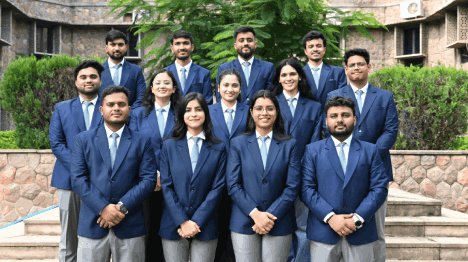- About Us
- Academics
Schools
Programs
General Information
- Faculty
The faculty members and researchers working at IIHMR University come from varied backgrounds including, but not limited to medicine, public health, management, economics, statistics, demography, human geography, social and behavioral sciences, rural development and pharmaceuticals.
- Admissions
- Research
.Publications & Journal
- Executive Education
Executive Programmes
- Online Certification Courses
ONLINE CERTIFICATION Courses
- Training
- Placements
- Fee Payment
- NAAC
- IQAC
- NIRF
- Webinars
- About Us
- About IIHMR University
- Board of Management
- Academic Council
- Board of Studies
- Research Board
- Institutional Review Board
- Finance & Audit Committee
- Departmental Research Committee
- Chairperson's Message
- President's Message
- IIHMR University Act
- Infrastructure
- Collaboration
- Ranking
- Board of Studies (School of Digital Health)
- Awards & Accolades
- Academics
- Institute of Health Management Research
- School of Pharmaceutical Management
- School of Development Studies
- School of Digital Health
- SD Gupta School of Public Health
- MBA (Hospital and Health Management)
- MBA (Pharmaceutical Management)
- MBA (Development Management)
- MBA (Healthcare Analytics)
- Master of Public Health
- Student Manual – Cohort 9 (2021-2023)
- Master of Public Health (Cooperative programme with Johns Hopkins University)
- Ph. D.
- MBA CSR & ESG Management (Executive)
- MBA Sustainable Business Management (Executive)
- Common Information for all the Programs
- Academic Calendar
- Student Handbook 2020-21
- Committees
- Policies
- Annual Exam Calendar
- Library
- Faculty
- Officers of University
- Dean of Institute of Health Management Research
- Dean of School of Pharmaceutical Management
- Dean of School of Development Studies
- Dean of SD Gupta School of Public Health
- Dean of School of Digital Health
- School of Digital Health
- Faculty List A to Z
- Faculty List Designation Wise
- Faculty List School Wise
- Admissions
- Research
- Executive Education
- Training
- Placements
- Alumni
- Events
- Job Openings
- Contact
- Research
Assessment to Understand Social Determinants Around Vaccine Hesitancy and Acceptance
Agency : State Institute of Health & Family Welfare
Covering an area of 3,42,239 sq. km (1,32,150 sq. mi) Rajasthan is the largest state in the Republic of India. The growth rate of the population in the state at 28.41 % was higher than that of the country 21.34 %. The state is thriving towards attaining the desired results on health indices especially the maternal and child health and making a concerted effort in improving the quality and access of maternal, newborn, and childcare as well as vaccination. Various study indicates a remarkable reduction in child mortality in countries with poorest child survival indicators following the introduction of immunization against vaccine-preventable diseases. In Rajasthan, the most recent NFHS-4 indicates that more than half (55%) of children aged 12-23 months received all basic vaccinations against six major childhood illnesses (tuberculosis, diphtheria, pertussis, tetanus, polio, and measles) at any time before the survey. However, most children are at least partially vaccinated. 65% have received at least the recommended three doses of the polio vaccine, 72% have received the three recommended doses of DPT vaccine, and 78% have been vaccinated against measles. Eighty-nine percent of children have received a BCG vaccination. Though it is important to prevent the morbidity and mortality associated with vaccine-preventable diseases and their complications yet in the state of Rajasthan 7of the children have not received any vaccinations at all. Far fewer children have received other basic vaccinations. In the state of Rajasthan in some of the districts (5 to 6) the dropout and hesitancy to continue the vaccination were noticed. There is a considerable dropout between the first and third doses of DPT vaccine (from 86% to 72%) and the polio vaccine (from 88% to 65%). Between NFHS-3 and NFHS-4, there were large increases in vaccination coverage for three doses of DPT (from 39% to 72%), measles (from 43% to 78%), and BCG (from 69% to 89%); however, coverage for three doses of polio vaccine has remained unchanged at 65 percent during this period. Further, the disparity is also evident among the coverage with all basic vaccinations, where it is higher in urban areas than in rural areas (61% versus 53%) and is high for children whose mothers have 12 or more years of schooling, for first births and female children. Muslim children have lower vaccination coverage than Hindu children and scheduled tribe children to have lower vaccination coverage than children from any other caste/tribe group. Hence to optimize control of vaccine-preventable diseases in communities, high uptake rates of vaccines must be achieved. Therefore, there is a great need to understand individual and community hesitation and reluctance towards vaccination.
Objective of Project:
- To assess the degree of vaccine hesitancy in acceptors and non-acceptors for specific vaccines administered under the Universal Immunization Programme in selected districts of Rajasthan.
- To assess the salient factors influencing vaccine hesitancy for specific vaccines administered under the Universal Immunization Programme in selected districts of Rajasthan.



